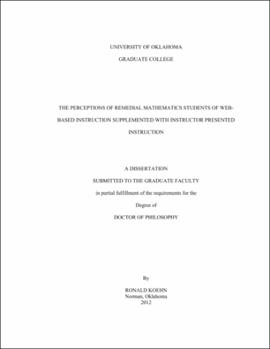| dc.contributor.advisor | Reeded, Stacy | |
| dc.creator | Koehn, Ronald | |
| dc.date.accessioned | 2019-04-27T21:25:02Z | |
| dc.date.available | 2019-04-27T21:25:02Z | |
| dc.date.issued | 2012 | |
| dc.identifier | 99171063702042 | |
| dc.identifier.uri | https://hdl.handle.net/11244/318635 | |
| dc.description.abstract | There are a large number of students entering colleges and universities that are in need of remediation before they can begin their college-level classes. Nationwide, it is reported that 36 percent of incoming freshmen take a remedial class (Aud, Hussar, Kena, Bianco, Frohlich, Kemp, & Tahan, 2011). Traditional methods of remediation for these students consisting of lectures and written homework assignments are being replaced with web-based models of instruction. Much of this web-based instruction is based on the theory of mastery learning (Dalton & Hannafin, 1988; Hagerty & Smith, 2005). Mastery learning purports that with enough time any student can master a subject. In order to achieve this, instruction may need to be presented in different ways and using different materials. Along with this, a tutor should be provided for each student, students should be allowed to work at their own pace and choose their own paths through the learning tasks, and regular assessments should be administered to determine if mastery learning has occurred (Bloom, 1968; Carroll, 1963). | |
| dc.description.abstract | For this study, the web-based ALEKS system was used. The ALEKS system uses mastery learning as part of its theoretical design. The majority of instruction for the class was given through the ALEKS system with an instructor present to give help on an individual basis and to present weekly lessons over topics a large number of students were ready to learn. | |
| dc.description.abstract | The purpose of this study was to determine how students' perceptions of their abilities to perform basic algebra tasks in a remedial mathematics class were affected by computer-based instruction and what the students' perceptions were about having received verbal instruction from an instructor along with computer-based instruction. Answers to these questions were obtained by an analysis of responses given by students to weekly journal questions and an end of semester survey. The study was conducted as a phenomenological study where the purpose was to determine what common experiences the students shared under the method of instruction. The analysis was conducted using the constant comparison method of Glaser and Strauss (Glaser, 1965; Glaser & Strauss, 1967). | |
| dc.description.abstract | As a result of this analysis, five main affects of computer-based instruction surfaced: the students felt they were able to work at their own pace, they were learning on their own, they were motivated by learning on a computer, they felt less self-conscious about their learning, and they were able to learn more and better and retain it longer. The analysis also showed that student perceptions of receiving instruction from a computer and an instructor fell into five general categories: there was no need to receive instruction from an instructor, the instructor should be there to give instruction on an individual basis only, the instructor should give occasional instruction to the entire class on a topic they were ready to learn, the instructor should present instruction to the entire class along with individual help, and the instructor should be presenting all instruction. | |
| dc.format.extent | 150 pages | |
| dc.format.medium | application.pdf | |
| dc.language | en_US | |
| dc.relation.requires | Adobe Acrobat Reader | |
| dc.subject | Algebra--Web-based instruction | |
| dc.subject | Mathematics--Remedial teaching | |
| dc.subject | Algebra--Study and teaching (Secondary) | |
| dc.subject | College students--Attitudes | |
| dc.title | The Perceptions of Remedial Mathematics Students of Web-Based Instruction Supplemented With Instructor Presented Instruction | |
| dc.type | text | |
| dc.type | document | |
| dc.thesis.degree | Ph.D. | |
| ou.group | Jeannine Rainbolt College of Education::Department of Instructional Leadership and Academic Curriculum | |
